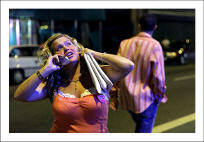
In 1989 John Williams toured the badlands of America seeking out its crime writers. Amongst those he tracked down were Carl Hiaasen, James Ellroy, Elmore Leonard, Sara Paretsky, George V Higgins, Eugene Izzi and James Lee Burke. For him these were the true chroniclers of American life, unafraid to tackle issues like crime, poverty and race - issues ducked by more "literary" authors in an era of political conservatism.
Staying in the kind of lowlife motels that featured in the works of his heroes and immersing himself in the seedy locales that inspired their fiction, he wrote
Into the Badlands, a book that would introduce a new wave of American crime writers to a British audience. What shouldn't be forgotten either is that it is an absolutely cracking piece of travel writing.
Fifteen years on, after a massive boom in the genre, Williams has gone
Back to the Badlands to interview some of the writers he missed first time around and to gauge whether the heartbeat of American life can still be most keenly felt through the pages of its crime fiction.
Back to the Badlands is in two parts: Part 1 consists of 5 chapters taken from
Into the Badlands (basically interviews with Hiaasen, Burke, Ellroy, Crumley and Leonard); whilst Part 2 features 5 additional writers.
So which new authors made it into Williams updated book? First up, a ride around Washington DC in George P Pelecanos' Infiniti G 35; then it's skydiving (well almost) with Vicki Hendricks in Florida; a tour of SoCal surf spots with Kem Nunn; on the campaign trail with Kinky Friedman in Austin, Texas; and finally a refreshing swim with Daniel Woodrell deep in the Ozarks. Which, all things considered, is a pretty cool way to spend a month of one's life.
The new chapters follow the same winning formula: Williams books into a downbeat motel, hits the streets checking out local record shops, diners, and bars - then goes and interviews an interesting writer. Essentially you get two perspectives of a given place - Williams' own outsider observations followed by the author's insider knowledge. Of course, you also get plenty of fascinating biographical information about the authors themselves and why they do what they do.
General differences between the 1989 chapters and the 2006? I'd say, inevitably, the new stuff is more reflective, less earnest, than the earlier interviews. Williams seems to be having a lot more fun this time around. He's (slightly) less of a fan boy and, as a respected writer/editor himself, maybe meeting his interviewees on more equal terms. Which is all a long-winded way of saying he's older now.
Things I especially like about the book are the humour; its spirit of adventure; Williams' obvious love for American pop culture; and his er, anorak knowledge of music (Jandek anyone?) and crime fiction. Perhaps the best recommendation I can give is that after reading
Back to the Badlands you end up with a list of books you simply have to get your hands on. But do yourself a favour - get your hands on this one first.
Back to the Badlands, published by Serpent's Tail, is on sale now. The missing chapters from
Into the Badlands can be found on Williams' own
website along with a few other interesting bits and pieces.









